The Supermicro Storage SuperServer SSG-121E-NES24R is a dual-socket server that supports the latest 4th generation Intel Xeon Scalable processors, up to 32 DIMMs, and support for 24 E1.S SSDs. The server is designed for hyperscalers and others that require massive scale and density via the 24 hot-swappable NVMe drive bays, PCIe 5.0 x16 expansion slots, and two OCP slots. Additionally, the server features redundant 2000W power supplies to ensure maximum uptime and reliability.
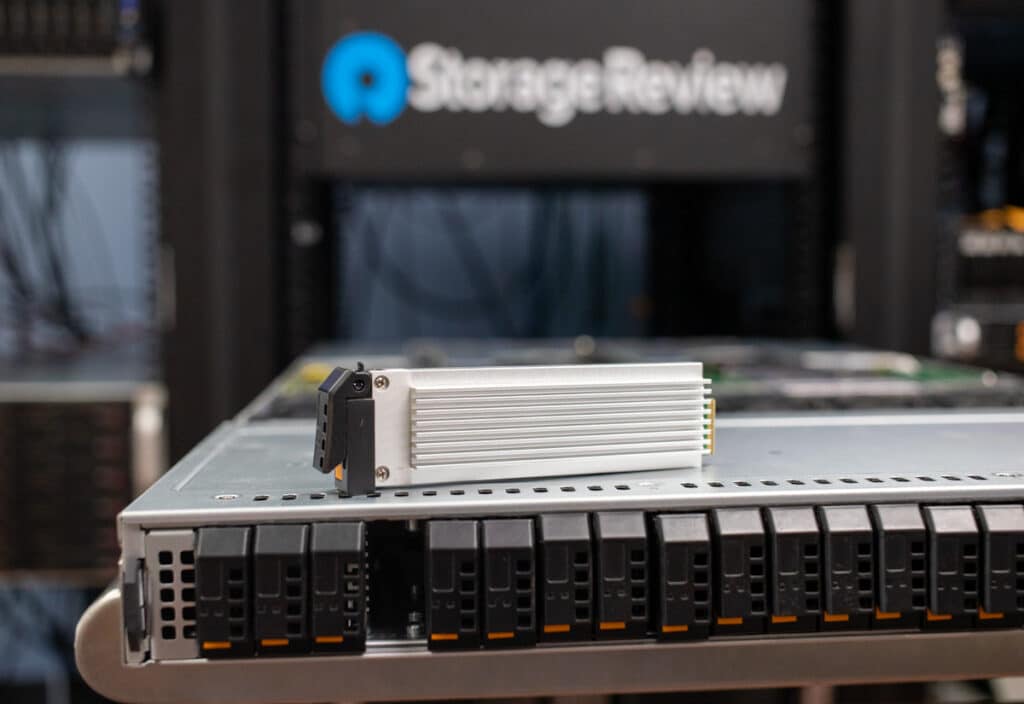
The SSG-121E-NES24R’s focus on the E1.S SSD form factor makes it an ideal choice for dense and massive-scale servers. Primarily this allows for a high storage density, as the server can accommodate 24 NVME SSDs in a single rack U. This is particularly important for hyperscale data centers that require high-capacity storage but have limited physical space available to them. Moreover, the server supports Gen5 E1.S SSDs, which means even more performance as more Gen5 SSDs come to market.
The Supermicro server is also equipped with dual-socket E (LGA-4677) architecture and support for 4th-generation Intel Xeon Scalable processors. This means powerful and efficient processing capabilities, as they are designed for demanding workloads. Moreover, this dual-socked at 4th gen combination supports a TDP (thermal design power) range of 145W to 270W, making the SuperServer SSG-121E-NES24R well-suited for use where high-performance computing and large-scale data processing are required.
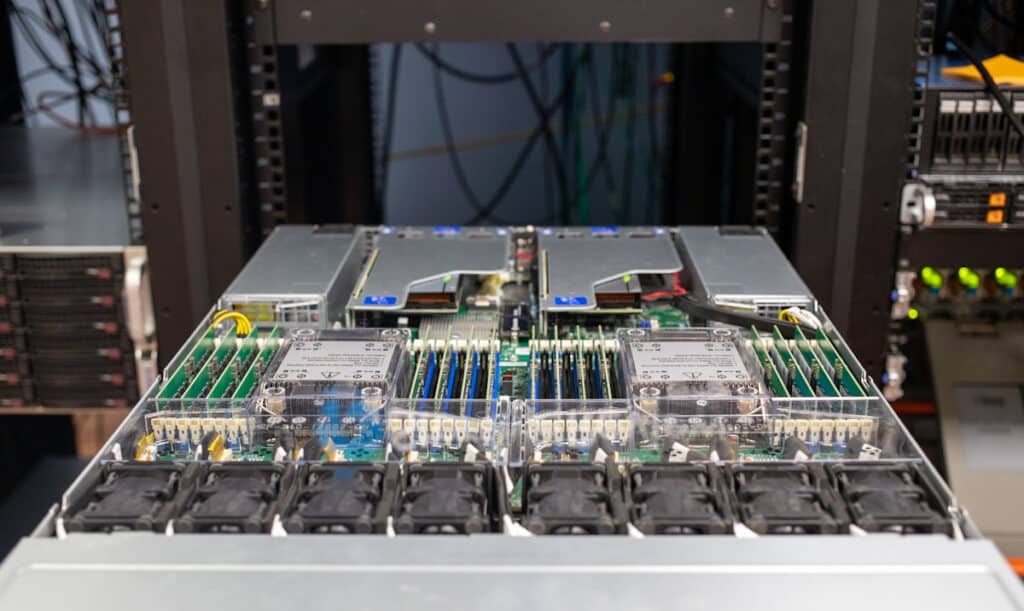
The SSG-121E-NES24R is outfitted with 32 DIMM slots, bringing a maximum memory capacity of 8TB via 256GB DRAM modules, which will help make it thrive when running data-intensive applications like machine learning and big data analytics. The server also supports a variety of memory types, including up to 4800MHz ECC DDR5 RDIMM and LRDIMM as well as a memory voltage of 1.1V with ECC error detection capabilities, the latter of which help ensure data accuracy and reliability.
The SuperServer SSG-121E-NES24R also provides a range of I/O ports for connectivity and management, including a single RJ45 dedicated IPMI LAN port, which allows for remote management and monitoring of the server and two OCP slots for NICs. It also comes with four USB 3.0 ports–two located on the front of the server and two on the rear–and includes the usual VGA port for video output, allowing it to connect to pretty much any monitor (even older legacy displays). Finally, the server features one COM port on the rear for serial connectivity, allowing for easy integration with other systems or devices.
Supermicro Storage SuperServer SSG-121E-NES24R Review Build
Our build is powered by dual Intel Xeon Platinum 8450H Processors, which support the maximum 8TB of RAM (4TB for each CPU) this SuperSever can be outfitted with. The 8450H has 28 cores and 56 threads, making it a powerful processor suited for demanding computing. It also has a base frequency of 2.00 GHz and can reach a maximum turbo frequency of 3.50 GHz, while featuring a cache of 75MB and a TDP of 250W.
The SSG-121E-NES24R server review build is equipped with 512GB of DDR5 RAM and ten SK hynix PE8110 3.84TB E.1 Gen4 SSDs.
Supermicro Storage SuperServer SSG-121E-NES24R Specifications
| Motherboard | |
| Super X13DSF-A | |
| Processor | |
| CPU |
|
|
|
| System Memory | |
| Memory |
|
| Memory Voltage |
|
| Error Detection |
|
| On-Board Devices | |
| Chipset |
|
| Network Connectivity |
|
| IPMI |
|
| Input / Output | |
| LAN |
|
| USB |
|
| Video |
|
| Serial Port |
|
| System BIOS | |
| BIOS Type |
|
| Management | |
| Software |
|
| Power Configurations |
|
| PC Health Monitoring | |
| CPU |
|
| FAN |
|
| Temperature |
|
| Chassis | |
| Form Factor |
|
| Model |
|
| Dimensions and Weight | |
| Height |
|
| Width |
|
| Depth |
|
| Package |
|
| Weight |
|
| Available Color |
|
| Front Panel | |
| Buttons |
|
| LEDs |
|
| Expansion Slots | |
| PCI-Express (PCIe) |
|
| Drive Bays / Storage | |
| Hot-swap |
|
| M.2 |
|
| System Cooling | |
| Fans |
|
| Power Supply | |
| 2000W 1U redundant power supply W73.5 x L203 x H40mm | |
| Dimension
(W x H x L) |
|
| AC Input |
|
| +12V |
|
| 12V SB |
|
| Output Type |
|
| RoHS |
|
| Environmental Spec. |
|
Supermicro Storage SuperServer SSG-121E-NES24R Design and Build
Supermicro SuperServer SSG-121E-NES24R is a compact system with 24 hot-swap E1.S (15mm or 9.5mm) NVMe drive bays (x4 PCIe Gen5) stacked along the front panel. Each drive bay features an activity and a status LED indicator.
To the right are the two USB 3.0 ports and the control panel, the latter of which has the information, dual NIC, HDD, and Power LED indicators as well as the reset (reset the BMC or reboot the system) and power buttons. The pull-out tag is located on the left.
The drive bays are hot-swappable, which makes it easy to remove the drives without requiring any tools. Unfortunately, the drive caddies are not toolless, the clips have to be secured to the SSD with two screws.
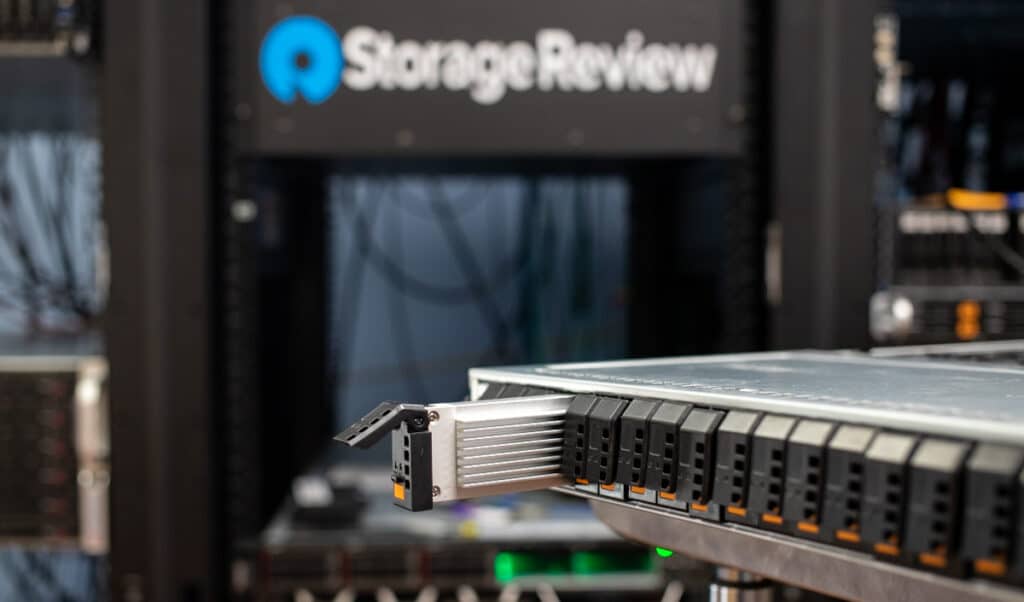
At the rear are the redundant power supply connectors on either side, the dedicated LAN port for out-of-band management, two USB 3.0 ports, the usual VGA port, and four expansion slots (two PCI 5.0 x16, two AIOM).
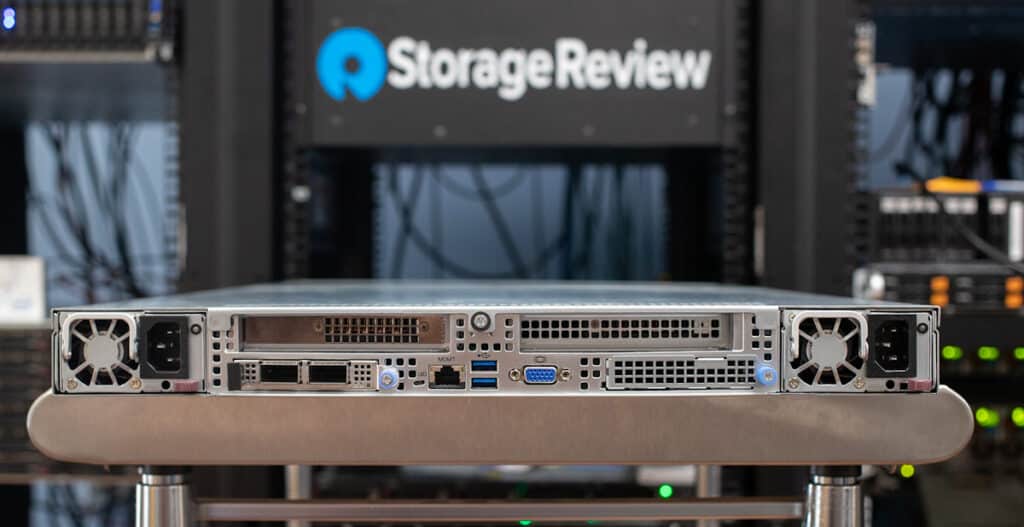
Inside, you will notice the power supply modules (and PCIe slots) located at the back of the motherboard, surrounding the M.2 drive slot. Toward the front, there are 32 DIMMs that encircle the dual CPUs and their accompanying heatsinks. Completing the setup are the heavy-duty 4cm fans and storage backplane.
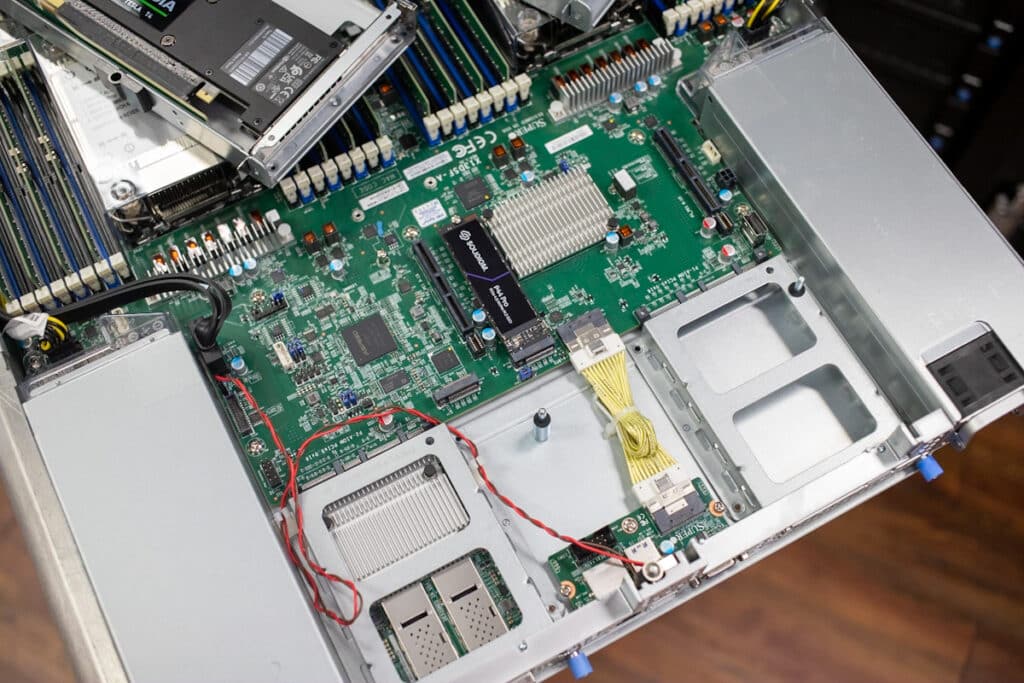
While not used for this review, we did install two Tesla T4 GPUs (shown below), which are designed for AI inferencing workloads. With 16GB of GDDR6 memory and 320 Turing Tensor Cores, these GPUs offer 2,560 CUDA cores and support NVIDIA’s TensorRT and TensorFlow libraries (which are standard tools for machine learning training and inference tasks). These GPUs will come into play in future content.
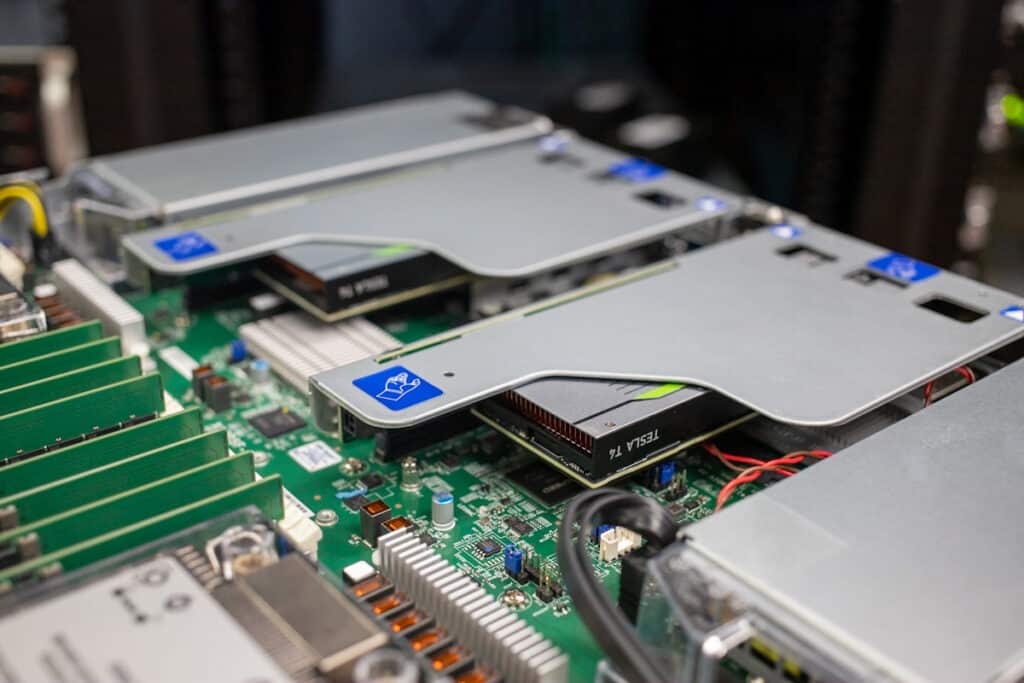
Supermicro Storage SuperServer SSG-121E-NES24R Performance
Our review system is configured with the following key components for CPU testing:
- Dual Intel Xeon Platinum 8450H Processors (base frequency of 2.00 GH, max turbo frequency of 3.50 GHz)
- 512GB DDR5 RAM
- Ten SK hynix PE8110 3.84TB E.1 Gen4 SSDs
Cinebench R23 is a widely used benchmarking tool that measures the performance of CPUs and GPUs using Maxon Cinema 4D for rendering. It provides a score that can be used to compare the performance of different systems and components.
| Cinebench R23 Multi | 60,116 |
| Cinebench R23 Single | 1,180 |
HWBOT x265 Benchmark, hosted on hwbot.org, measures the performance of a system by rendering a video in 1080P or 4K resolution using the x265/HEVC encoder. It is designed to take advantage of modern CPU instruction sets and is optimized for multi-threaded performance for competitive benchmarking.
| HWBOT x256 (1080p) | 51.59 |
| HWBOT x256 (4K) | 33.749 |
| HWBOT x256 2x overkill (4K) | 58.795 |
| HWBOT x256 3x overkill (4K) | 64.035 |
y-cruncher is a multi-threaded and scalable program that can compute Pi and other mathematical constants to trillions of digits. Since its launch in 2009, it has become a popular benchmarking and stress-testing application for overclockers and hardware enthusiasts.
| y-cruncher 1b (1Billion Digits) | 9.038s |
| y-cruncher 10b (10Billion Digits) | 107.458s |
Blender benchmark measures the 3D rendering performance of a CPU or GPU by rendering a 3D scene in the Blender software. It provides a score that can be used to compare the performance of different systems and components.
| Blender CLI CPU Only | |
| Monster | 415.223408 |
| Junkshop | 264.607590 |
| Classroom | 208.902507 |
| Total | 888.733505 |
Supermicro Storage SuperServer SSG-121E-NES24R Storage Performance
When it comes to benchmarking storage devices, application testing is best, and synthetic testing comes in second place. While not a perfect representation of actual workloads, synthetic tests do help to baseline storage devices with a repeatability factor that makes it easy to do apples-to-apples comparisons between competing solutions. These workloads offer a range of different testing profiles ranging from “four corners” tests, and common database transfer size tests, to trace captures from different VDI environments.
All of these tests leverage the common vdBench workload generator, with a scripting engine to automate and capture results over a large compute testing cluster. This allows us to repeat the same workloads across a wide range of storage devices, including flash arrays and individual storage devices. Our testing process for these benchmarks fills the entire drive surface with data, and then partitions a drive section equal to 25% of the drive capacity to simulate how the drive might respond to application workloads. This is different from full entropy tests which use 100% of the drive and takes them into a steady state. As a result, these figures will reflect higher-sustained write speeds.
We configured the Supermicro SSG-121E-NES24R with ten 3.84TB SK Hynix PE8110 SSDs for our synthetic workload test. The operating system is Ubuntu-22.04.1.
Profiles:
- 4K Random Read: 100% Read, 128 threads, 0-120% iorate
- 4K Random Write: 100% Write, 128 threads, 0-120% iorate
- 16K Sequential Read: 100% Read, 32 threads, 0-120% iorate
- 16K Sequential Write: 100% Write, 16 threads, 0-120% iorate
- 64K Sequential Read: 100% Read, 32 threads, 0-120% iorate
- 64K Sequential Write: 100% Write, 16 threads, 0-120% iorate
- 4K, 8K, and 16K 70R/30W Random Mix, 64 threads, 0-120% iorate
- Synthetic Database: SQL and Oracle
- VDI Full Clone and Linked Clone Traces
Starting off in random 4k reads, the Supermicro SuperServer SSG-121E-NES24R showed a peak performance of 4.44 million IOPS at just 99.5µs in latency when outfitted with ten SK hynix PE8110 3.84TB E.1 Gen4 SSDs.
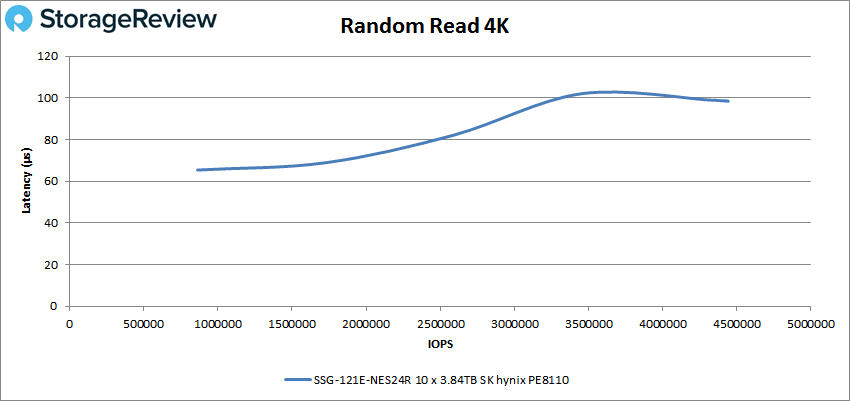
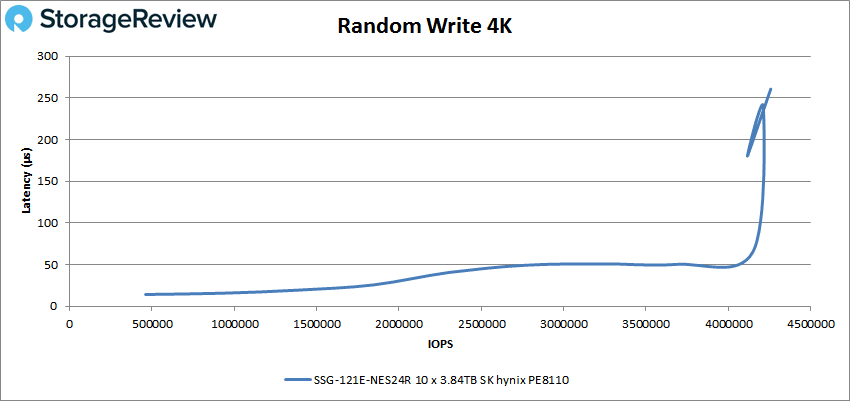
Moving on to 64k sequential performance, the SSG-121E-NES24R peaked at 51.8GB/s (828K IOPS) read with a latency of 496.5µs.
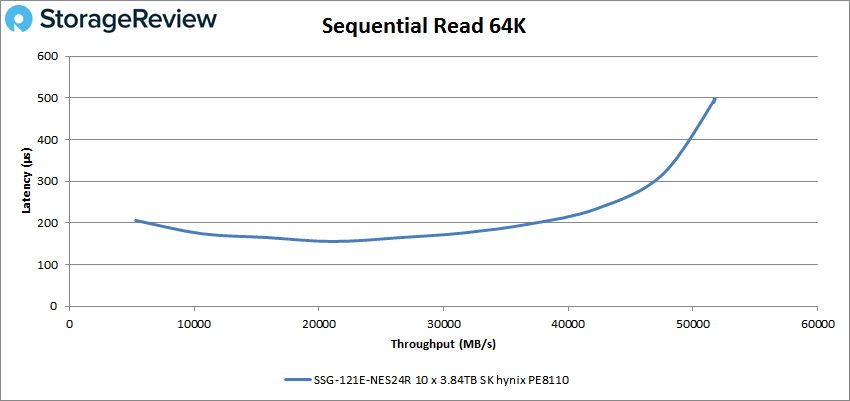
For 64k sequential writes, the SSG-121E-NES24R recorded a peak performance of 17.9GB/s (286K IOPS), where it took a spike in latency at the end of the test with 582µs.
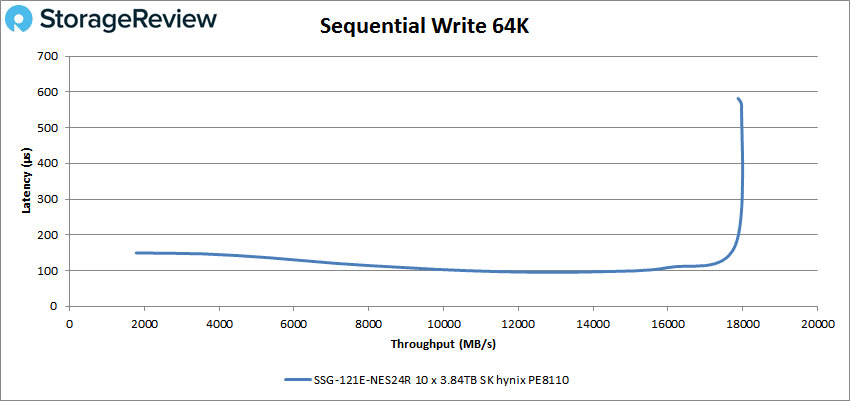
In 16K sequential performance for writes, the SSG-121E-NES24R posted 18.3GB/s (1.17 million IOPS) and 72.6µs in latency.
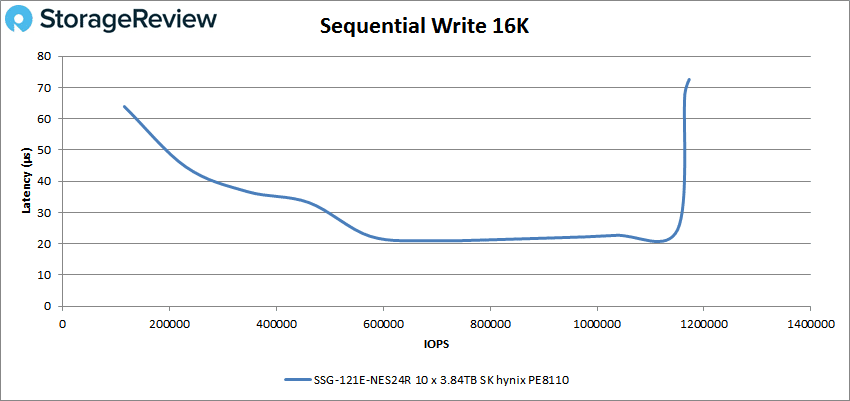
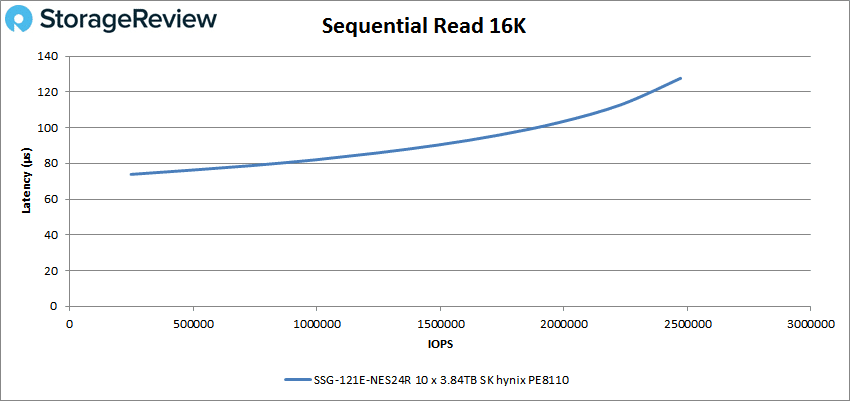
Next up is our mixed workloads, starting with our mixed 70/30 4k profile (70% read, 30% write). Here, the SSG-121E-NES24R peaked at 4.3 million IOPS with a latency of 135.4µs.
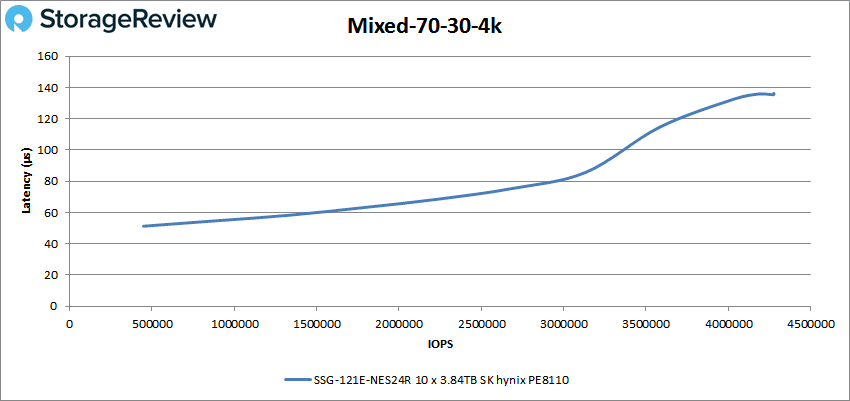
In our mixed 70/30 16K profile, the Supermicro SSG-121E-NES24R yielded a peak of 1.48 million IOPS at 387.5µs in latency.
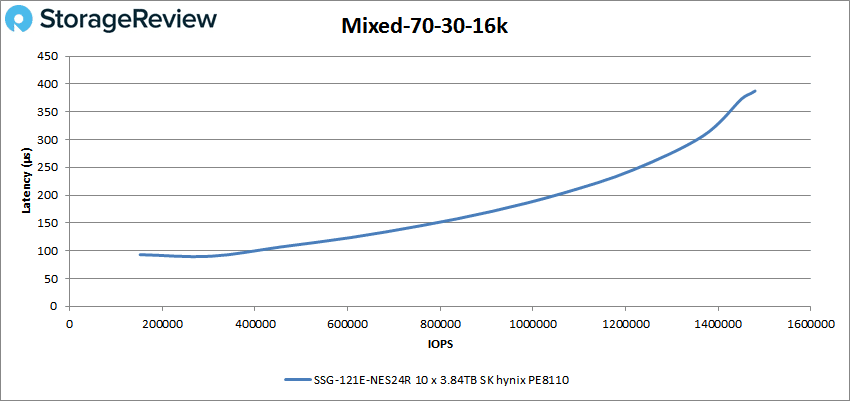
In our last mixed profile (70/30 8k), the SSG-121E-NES24R has another steady performance result, peaking at 2.76 million IOPS with a latency of 217.4µs.
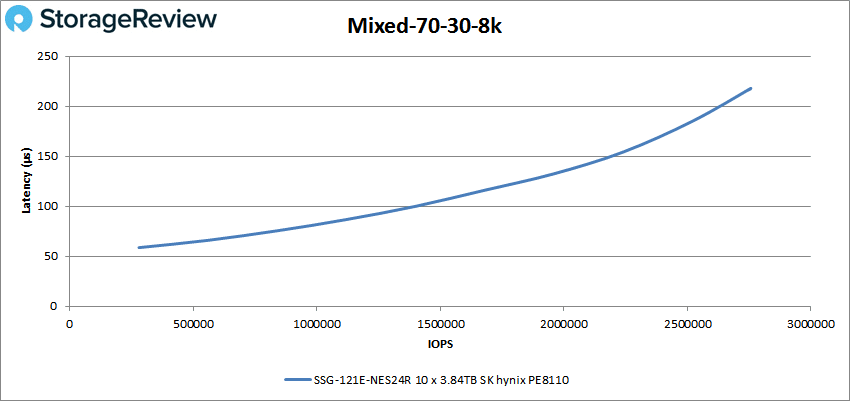
Our next set of tests is our SQL workloads: SQL, SQL 90-10, and SQL 80-20. Starting with SQL, the new Supermicro server posted a peak performance of 2.84 million IOPS with a latency of just 100.4µs before suffering from a spike in performance at the very end.
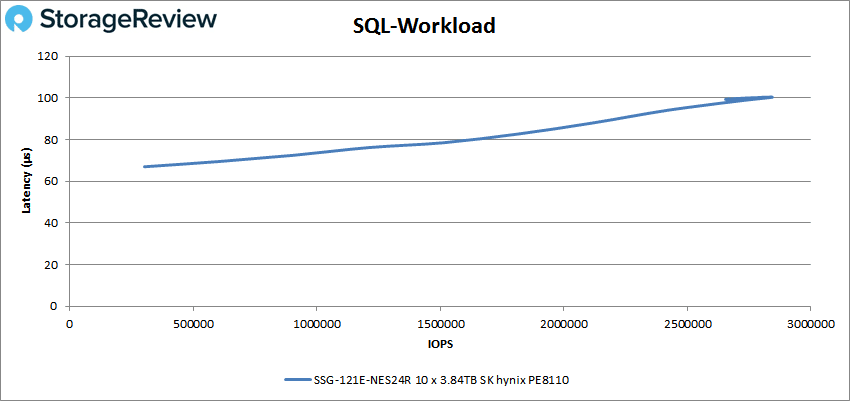
In SQL 90-10, the Supermicro SSG-121E-NES24R was able to peak at 2.32 million IOPS with a latency of 117.4µs.
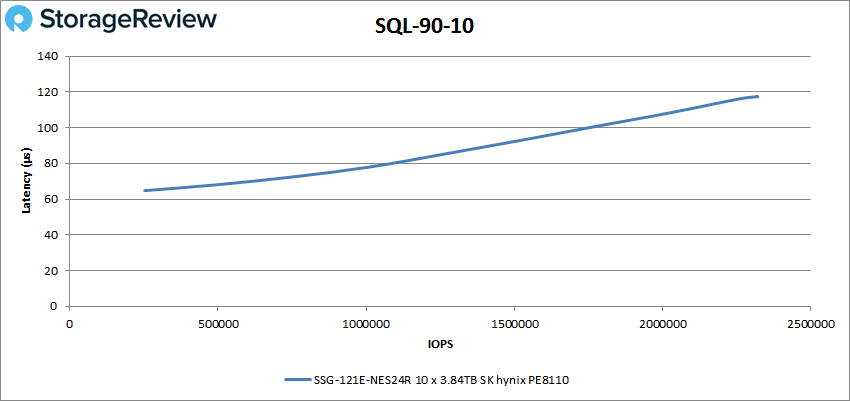
With SQL 80-20, the SSG-121E-NES24R peaked at 2.14 million IOPS with a latency of 99.3µs.
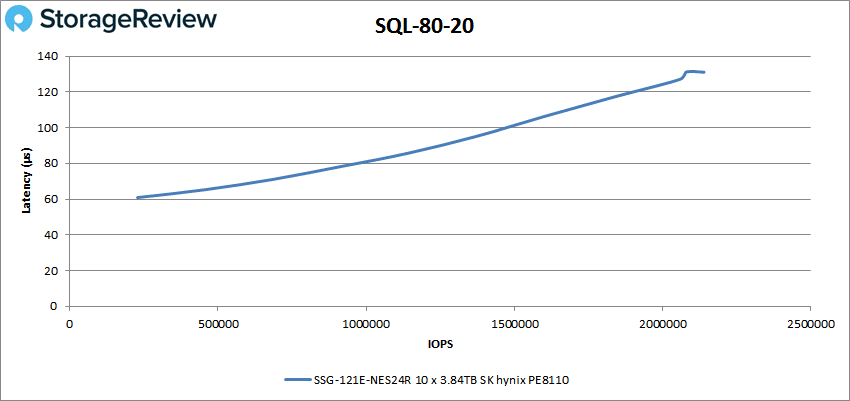
Next up are our Oracle workloads: Oracle, Oracle 90-10, and Oracle 80-20. Starting with the general Oracle workload, the SSG-121E-NES24R had a peak performance of 1.97 million IOPS at 147.5µs. This result means it is certainly capable of handling a very large number of database transactions per second.
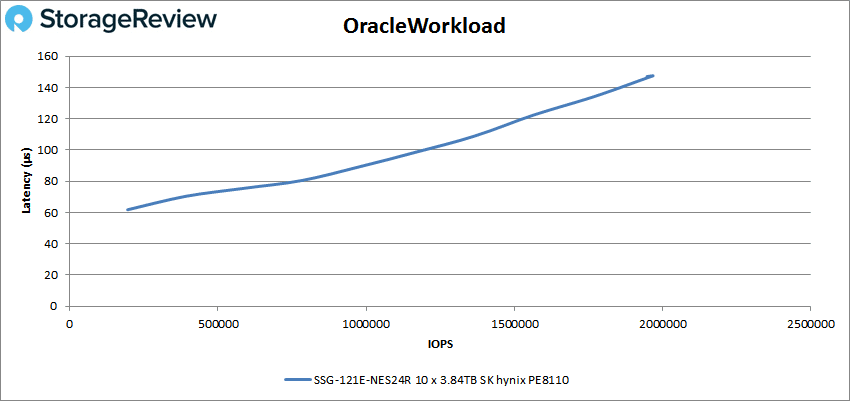
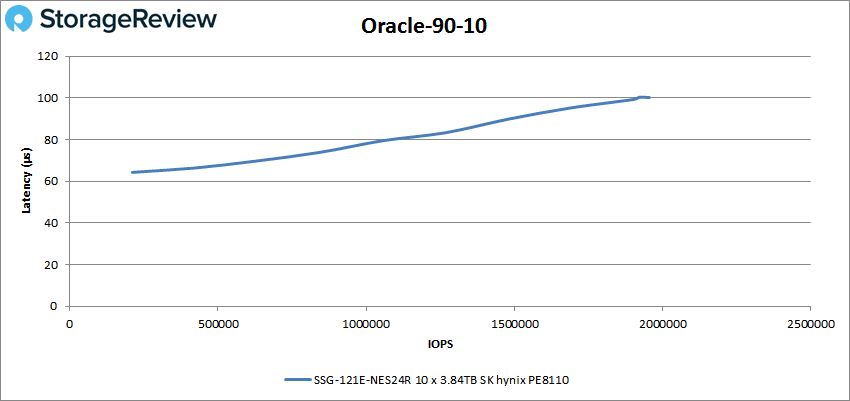
Next up is Oracle 80-20. Here, the SSG-121E-NES24R peaked at 1.78 million IOPS with 109.5µs in latency.
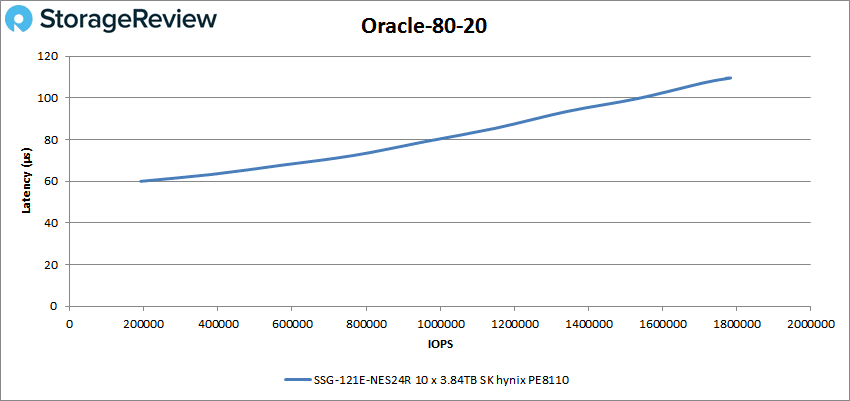
Next, we switched over to our VDI clone test, Full and Linked, where the 9400 continued its great performance. For VDI Full Clone (FC) Boot, Supermicro SSG-121E-NES24R at 1.76 million IOPS with a latency of 156.8µs.
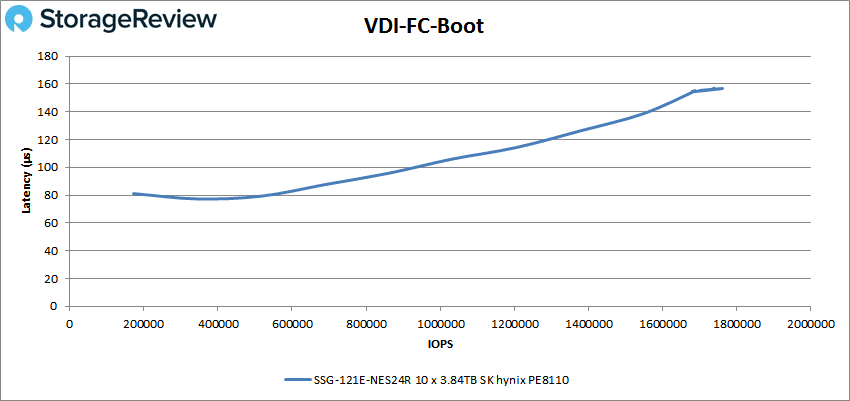
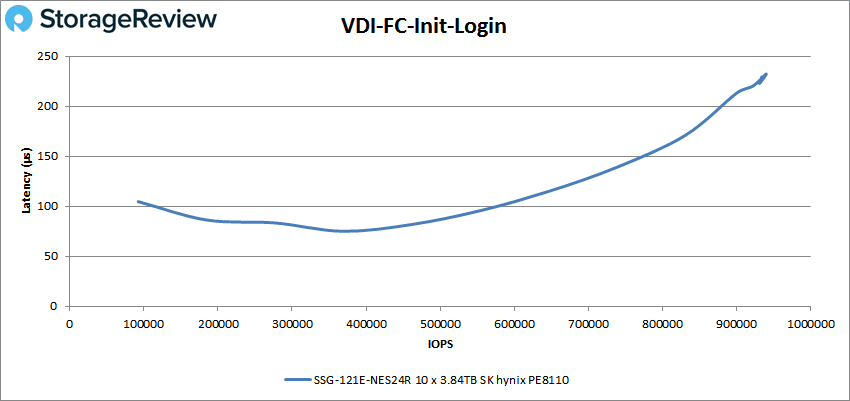
VDI FC Monday Login performance showed a peak of 651K IOPS with a latency of 165.5µs.
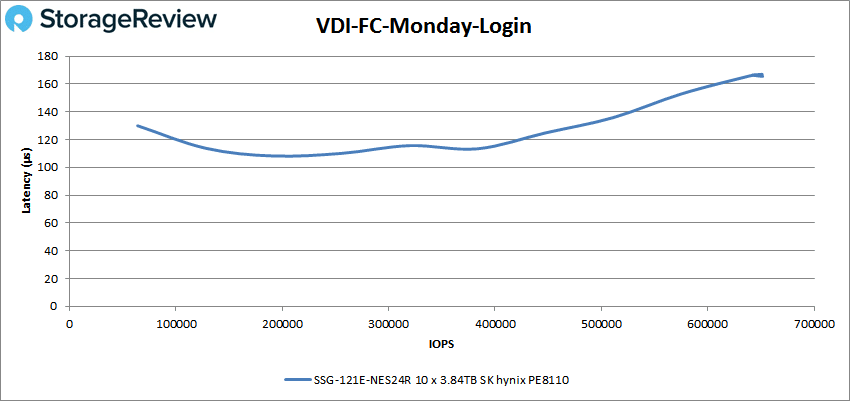
For VDI Linked Clone (LC) Boot, the Supermicro SSG-121E-NES24R showed steady performance, peaking at 905K IOPS with 131.2µs (with a blip in IOPS at the very end).
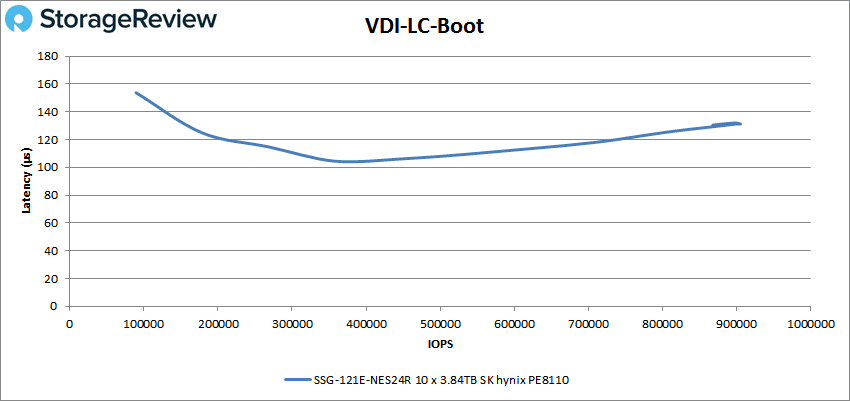
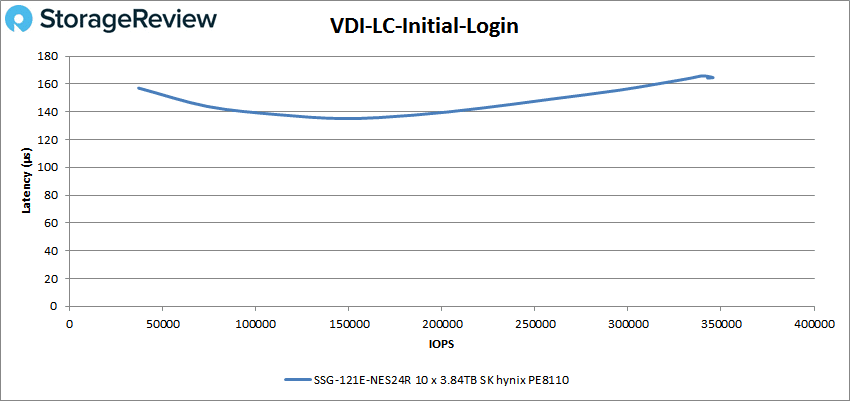
For VDI LC Monday Login, the SSG-121E-NES24R showed a peak of 497K IOPS with a latency of 213.7µs.
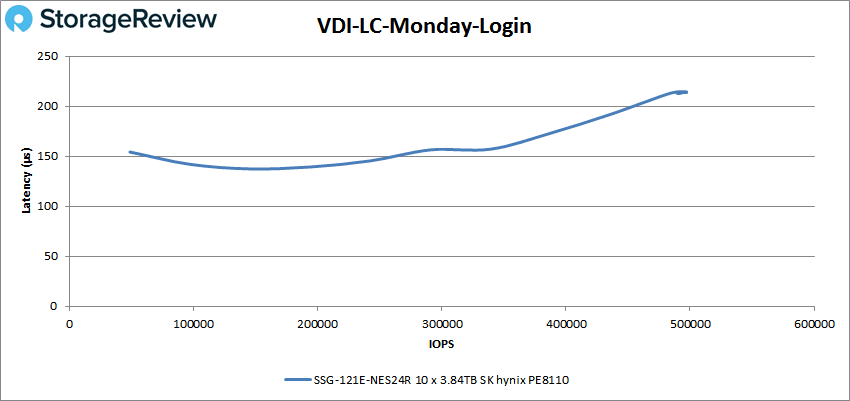
Conclusion
The SuperMicro SuperServer SSG-121E-NES24R is a performance-driven, compact server and an excellent option for those who require massive scale and density. This 24 hot-swappable E1.S NVMe server supports Intel’s 4th Gen Xeon Scalable Processors and PCIe Gen5 expansion (via two PCIe 5.0 x16 slots), allowing organizations to leverage the latest-generation CPU, storage interface, and I/O modules.
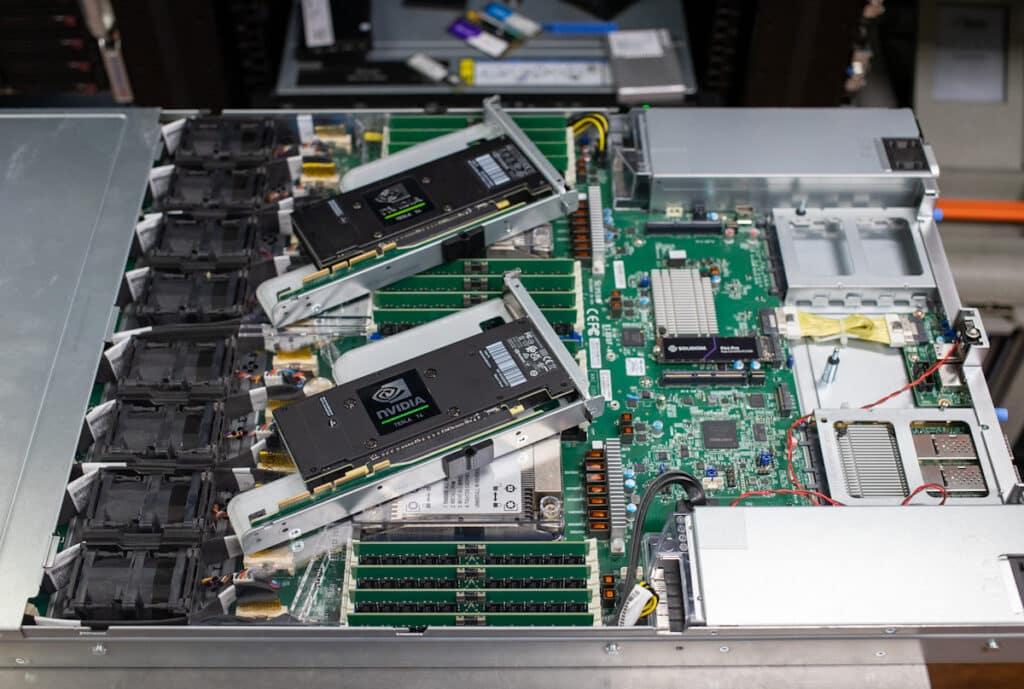
While this server can be run in liquid cooling configurations, the TDP range of 145W to 270W makes it suitable for air-cooled systems. With 32 DIMM slots, the server can support a maximum memory capacity of 8TB via 256GB DRAM modules, and it also supports various memory types, including up to 4800MHz ECC DDR5 RDIMM and LRDIMM. Further, there are twin PCIe slots that can be used for inferencing GPUs and two OCP slots for i/O.
Overall, the SSG-121E-NES24R offers an impressive balance of flexibility and performance in an incredibly dense platform. While we weren’t able to push this server to the edge with just 10 E1.S SSDs, it’s clear that the potential to soar is there. As we get ahold of Gen5 SSDs that are just now coming to market in volume, it’s exciting to think about how much more performance is available within this system.
This review is just the beginning for this server in our lab. We’re already using it in an AI inferencing use case and we do intend to secure the SSDs required to stress the Intel CPUs to their max. E1.S SSDs clearly aren’t for every use case, but in spots where density and performance matter, they’re an amazing tool. And even if we don’t stress the storage, the raw compute power of this server as an application host is quite compelling. Much more to come.




 Amazon
Amazon